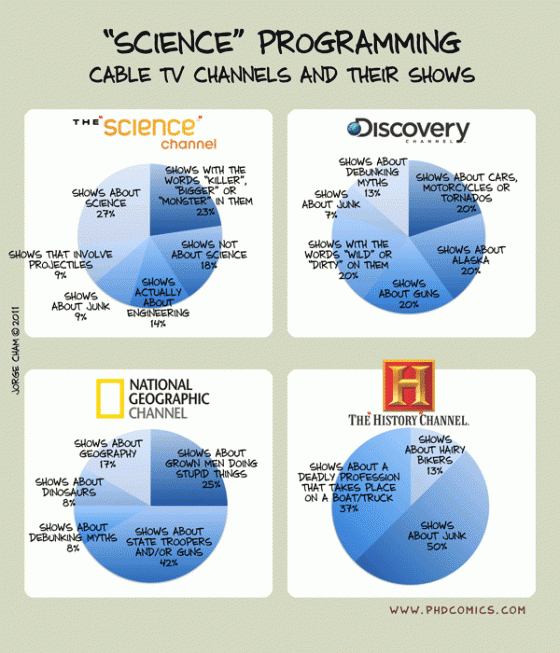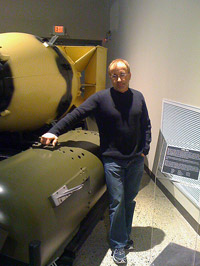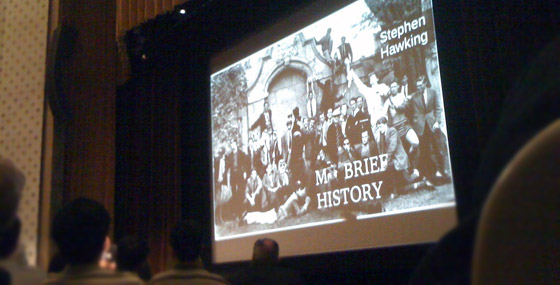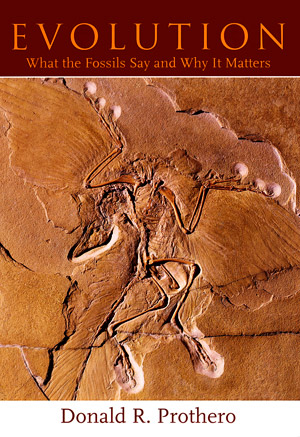by
Donald Prothero, Jan 25 2012

It happens with disgusting regularity. You will flip through the various basic cable channels which are nominally “science oriented” (often grouped together on the dial if they feature scientific topics) and come up with nothing but junk, pseudoscience, and worse. “Reality shows” about subjects with little or no science content, tons of paranormal and pseudoscientific shows promoting ghosts, UFOs, Bigfoot, and creationism—all fill the airwaves for channels like Discovery, The Learning Channel, History Channel, and even the Science Channel and National Geographic Channel. We watch a few minutes of these with complaints to anyone within earshot, then (usually) move on—or occasionally we get sucked in to watch the whole thing, like gawkers at a car crash. The cartoon at the top (from the great website PhdComics) says it all: four channels that used to be largely documentaries on science and history are now dominated by guns, explosions, dangerous occupations and other “reality” TV. Their shows have buzz words in the titles like “biggest”, “wildest”, “monsters” or “killers”, and plain old junk fill up most of their air time.
I’ve seen it from both sides. I’ve appeared in prehistoric animal documentaries that have aired on all four channels (and keep re-appearing years after I made them, so I feel like Dorian Gray, with my younger self perpetually preserved in documentary limbo). Almost all these documentaries are made by small independent film outfits that are searching for any sexy topic that they can sell to the major cable networks, so they are under great pressure to come up with something flashy, noisy, scary, and/or mysterious. If I have any chance to review the script, I try my best to tone down the excessive hyperbole, but they usually ignore me. As I film segments with them, I try to be as dynamic and entertaining as a “talking head” can be, but they are always pushing me to oversimplify and exaggerate to make the spiel more colorful (but less scientifically accurate). And then when I see the final product, most of what I did ends up on the cutting room floor, with only a few seconds left of many hours of filming. Even worse, I’ve put in many hours on projects that never got picked up at all. Documentary filmmaking is a high-risk, low-reward proposition—you have better odds of making big money in Vegas.
Continue reading…
comments (94)
by
Donald Prothero, Oct 26 2011
The Geological Society of America (GSA) is one of the largest organizations of geologists in the world (over 24,000 members). It holds not only an annual meeting every fall in a different city, but also five regional meetings around the U.S. regions (Northeast, Southeast, Midwest, Rocky Mountains, and Cordilleran) throughout the year. Although 97 different countries contribute members, it is composed mostly of U.S., Canadian, and some Central American geologists. The GSA focuses on the cutting-edge and pure research aspects of geology, performed mostly by academics and government geologists. Thus, it is very different from meetings of petroleum geologists or mining geologists or engineering geologists, who tend to be employed in for-profit enterprises and focus on purely practical local problems. The annual GSA meeting routinely draws 6000 or more people for a four-day session, so there are over 2000 talks and posters in at least 30 different sessions with talks every 15 minutes in at least 30 different rooms scattered around some huge convention center. There SO much to see and hear for a broadly trained and wide-ranging geologist/ paleontologist like myself that I can’t even catch a fraction of what I want to see and hear. For me, it is crucial to make the annual meeting each year to keep up with the latest developments, as well as see old friends that I see only at the meetings, and also to keep up with my geology textbooks and my other books sold in the gigantic exhibits area. I attended my first meeting in 1978 in Toronto, and I have not missed a national GSA since then. I just returned from this fall’s meeting in Minneapolis October 9-12, which was my 33rd in a row.
Most of the time when I attend the meetings, there are plenty of controversial topics and great debates going on within the geological community, so the profession does not suppress unorthodox opinions or play political games. This is the way it should be in any genuine scientific discipline. I’ve seen amazingly confrontational knock-down-drag-out sessions about particularly hotly debated ideas, but always conducted in a spirit of honest scientific exchange and always hewing to rules of science and naturalism. To get on the meeting program, scientists must propose to organize sessions around particular themes, along with field trips to geologically interesting sites within driving distance of the convention city, and the GSA host committee reads and approves these proposals. But every once in a while, I see a poster title and abstract with something suspicious about it. When I check the authors, they turn out to be Young-Earth Creationists (YEC) who claim the earth is only 6000 years old and all of geology can be explained by Noah’s flood. When I visit the poster session, it’s usually mobbed by real geologists giving the YECs a real grilling, even though the poster is ostensibly about some reasonable geologic topic, like polystrate trees in Yellowstone, and there is no overt mention of Noah’s flood in the poster. But the 2010 meeting last year in Denver took the cake: there was a whole field trip run by YECs who did not identify their agenda, and pretended that they were doing conventional geology—until you read between the lines.
Continue reading…
comments (27)
by
Donald Prothero, Jul 20 2011
I’ve just survived four days of The Amazing Meeting 9 in Las Vegas, and my head is buzzing with so many thoughts—so many great talks—so many friends I haven’t seen since TAM8 last year, and new ones I met for the first time after months of email and Facebook exchanges. TAM never fails to exhilarate me—and exhaust me. My favorites: Bill Nye’s brilliant pep talk for science and space exploration; Dawkins’ wonderful preview of his new book and his speculations about extraterrestrial life; PZ Myers’ very different take on the non-prevalence of humanoids on other planets; Elizabeth Loftus’ succinct review of her lifetime of research showing the unreliability of human memory; and especially the message at the end of both Neil DeGrasse Tyson’s and Sean Faircloth’s presentations: we need to dial back all the petty sniping within our ranks and realize that we face a very serious enemy out there of religious and political zealots who do not value science, skepticism, critical thinking, or “reality-based” political views. They outnumber us; they are well funded by right-wing think tanks and evangelical churches; and they have elected plenty of people in power who are already pushing their agenda. I realize that getting skeptics and freethinkers to work together is like herding cats, but we have a powerful entrenched opposition that will require every resource at our disposal to hold them at bay, let alone push them back. They are already eroding science education and displacing good science with pseudoscience in public policies.

But my favorite talk was Eugenie Scott’s presentation, “Deja Vu all over again: Denialism of Climate Change and Evolution.” It gave me a sense of deja vu, because apparently without knowledge of each others’ work, we have converged on a common topic. This is what philosopher William Whewell would call a “consilience” or common agreement of different lines of evidence or threads of argument. As I independently pointed out in my upcoming book written last summer about science denialism, entitled Reality Check, and in a paper I wrote which is now in press, there are tremendous parallels between the evolution-deniers (creationists), the climate change deniers, and many other types of science deniers. Even more striking, they borrow most of their tactics from the prototypical reality deniers, the Holocaust revisionists, along with the tactics of the tobacco companies in creating “doubt” through PR to obscure the real science.
Continue reading…
comments (44)
by
Brian Dunning, Jun 09 2011

130 scientists work at SETI, doing much more than you think you know.
A couple of weeks ago, I was at the SETI Institute in Mountain View, California. I had a couple hours to spare, so planetary scientist Dr. Franck Marchis invited me to swing by for a quick tour. I reluctantly (not) accepted.
There was an obvious elephant in the room. The news had been reporting that SETI had lost its funding, and since I (like most people) assumed that SETI consisted of 4 or 5 people in a crappy rented office somewhere, I was expecting to find those 4 or 5 people packing boxes and getting ready to move out, and polishing their resumes to get “real jobs” somewhere. I quickly learned that I couldn’t have been more wrong. Continue reading…
comments (48)
by
Donald Prothero, Apr 20 2011
The good thing about science is that it’s true whether or not you believe in it.
—Astrophysicist Neil DeGrasse Tyson, on “Real Time With Bill Maher”, Feb. 4, 2011
Reality is that which, when you stop believing in it, doesn’t go away.
—Philip K. Dick, author
It is far better to grasp the universe as it really is than to persist in delusion, however satisfying and reassuring.
—Carl Sagan
In recent years, both philosophers and science deniers (such as creationists) have repeatedly attacked the objectivity of science and scientists. Creationists claim that scientists are big frauds, deceived by a mass delusion about evolution. They argue that the stratigraphic sequence of fossils in the rock record is faked by evolutionists who shuffle the fossils and the strata in the order they need to prove evolution, then allegedly point to the same sequence as proof of evolution. (Never mind the fact that the objective, empirical sequence of fossils through geologic time was worked out by devoutly religious naturalists like William Smith and Georges Cuvier before 1800, at least 50 years before evolution was published by Charles Darwin). The Creation “Museum” in Kentucky is built upon the basic premise that “evolution scientists” and “creation scientists” start with the same data, but view them with different assumptions about the world–the fossils cannot speak for themselves, nor can the evidence falsify one position or the other.
On the other hand, philosophers and cultural critics have attacked science as well. Some philosophers have argued that outside reality is an illusion, and we can only know what we personally experience. If we do not perceive it, reality does not exist. More recently, the fad for deconstructionism in the non-scientific realms of academia argues that all our ideas are so culturally based and biased by our human prejudices that we cannot decide what is “real” or “objective.” This argumentation has gone in circles within philosophy for centuries. Philosophers of science, in particular, are fond of telling scientists what they should do, often without finding out what scientists actually do. Continue reading…
comments (38)
by
Donald Prothero, Apr 06 2011
With the GOP takeover of the House, the political climate surrounding controversial topics in science has changed radically. The extremists who now run the House Energy and Commerce Committee have been doing their best to challenge the enormous body of evidence supporting the reality of global climate change. On March 10, 2011, they set new lows for trying to redefine “greenhouse gases” to exclude carbon dioxide, methane, and all the other greenhouse gases that science has recognized. The situation was so ludicrous that Rep. Edward Markey (Democrat from Massachusetts) mocked their anti-scientific efforts by asking if they planned to repeal the laws of gravity, relativity, quantum mechanics, and heliocentrism. In his words:
Mr. Chairman, I rise in opposition to a bill that overturns the scientific finding that pollution is harming our people and our planet. However, I won’t physically rise, because I’m worried that Republicans will overturn the law of gravity, sending us floating about the room. I won’t call for the sunlight of additional hearings, for fear that Republicans might excommunicate the finding that the Earth revolves around the sun. Instead, I’ll embody Newton’s third law of motion and be an equal and opposing force against this attack on science and on laws that will reduce America’s importation of foreign oil. This bill will live in the House while simultaneously being dead in the Senate. It will be a legislative Schrodinger’s cat killed by the quantum mechanics of the legislative process! Arbitrary rejection of scientific fact will not cause us to rise from our seats today. But with this bill, pollution levels will rise. Oil imports will rise. Temperatures will rise. And with that, I yield back the balance of my time. That is, unless a rejection of Einstein’s Special Theory of Relativity is somewhere in the chair’s amendment pile. Continue reading…
comments (66)
by
Michael Shermer, Mar 01 2011

click to enlarge
On Saturday, February 5, 2011, my audio book producer John Wagner and I took a break from endless hours of my reading aloud (with John editing out my countless mistakes) my next book, The Believing Brain, which ironically includes chapters on UFOs, aliens, and conspiracy theories. Ironic because for this break John and I took what we thought would be an uneventful tour of the beautiful new National Museum of Nuclear Science and History in Albuquerque, New Mexico.
This is definitely a museum well worth visiting for a comprehensive tour of all things atomic. It was originally opened in 1969 as the Sandia Atomic Museum, but then changed in 1973 to the National Atomic Museum to include a broader history of the peaceful use of nuclear energy, and finally morphed into the new building that now houses the collection, which includes replicas of the Fat Man and Little Boy bombs (see photograph), along with a B-29, a B-52, an F-105, an A-7, an Atomic Cannon, a Titan II Rocket, a Minuteman Missile, a Jupiter Missile, a Thor Missile, and hundreds more smaller items inside the museum building itself, including these two amusing early uses of atomic energy for “health” purposes: Continue reading…
comments (50)
by
Michael Shermer, Feb 01 2011
Stephen Hawking lectures on “My Brief History,” packs the house

On Tuesday, January 18, 2011, physicist, cosmologist, writer, and science celebrity Stephen Hawking spoke in Caltech’s Beckman Auditorium on the subject of “My Brief History,” an autobiographical journey through the life of one of the most famous scientists in history.
Tickets were in such high demand that I had to go as a member of the press, writing for Scientific American, Skeptic, eSkeptic, and Skeptic.com, and even then it wasn’t clear I was getting in to actually hear the lecture until after the press junket that afforded us a photo opportunity to pose with The Great One (see below). Continue reading…
comments (9)
by
Michael Shermer, Dec 28 2010
In the tradition of making end-of-the-year lists of the “Top 10 X” I present my personal picks for the Top 10 Science Books of 2010. Most of these books are available in audio format as well as the old-school ink-on-bound-paper format, and I highly recommend Audible.com as the go-to source for easy listening to these selections while driving or riding your bike from your MP3 player or iPhone/iPod (use one ear bud instead of two so you can hear on-coming traffic, ambulances, etc.). Continue reading…
comments (34)
by
Daniel Loxton, Dec 22 2009

NASA visualization of arctic surface warming trends. NASA/Goddard Space Flight Center Scientific Visualization Studio, Larry Stock, Robert Gersten
As many skeptics know by now, legendary skeptical trailblazer James Randi set off a firestorm last week with two Swift blog posts about global warming. His first post carried his strong suspicion that consensus science on climate change is incorrect, while his followup post wondered “whether we can properly assign the cause to anthropogenic influences.”
Bloggers were swift to respond. Critics (including PZ Myers, Orac, Sean Carroll, and James Hrynyshyn) chastised Randi for speaking outside his domain expertise; for dissenting from current consensus science; and for lending his name to the disreputable “Oregon Petition Project.” Others, like Phil Plait, corrected Randi while sensibly reminding us that “anyone, everyone, is capable of making mistakes.” And, inevitably, global warming deniers seized upon the event. (One headline, at Britain’s Telegraph.co.uk, gleefully crowed “James Randi forced to recant by Warmist thugs for showing wrong kind of scepticism.”)
Continue reading…
comments (158)







